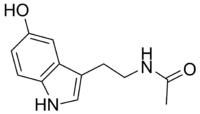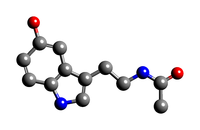- N-Acetylserotonin
-
N-Acetylserotonin 
 N-[2-(5-hydroxy-1H-indol-3-yl)ethyl]acetamideOther namesN-acetyl-5-hydroxytryptamine, N-acetyl-5-HT
N-[2-(5-hydroxy-1H-indol-3-yl)ethyl]acetamideOther namesN-acetyl-5-hydroxytryptamine, N-acetyl-5-HTIdentifiers CAS number 1210-83-9 PubChem 903 ChemSpider 879 
MeSH N-Acetylserotonin N-Acetylserotonin Jmol-3D images Image 1 - CC(=O)NCCC1=CNC2=C1C=C(C=C2)O
Properties Molecular formula C12H14N2O2 Molar mass 218.252 g/mol  (verify) (what is:
(verify) (what is:  /
/ ?)
?)
Except where noted otherwise, data are given for materials in their standard state (at 25 °C, 100 kPa)Infobox references N-Acetylserotonin (NAS), also known as normelatonin, is a naturally occurring chemical intermediate in the endogenous production of melatonin from serotonin.[1][2] It is produced from serotonin by the enzyme aralkylamine N-acetyltransferase (AANAT) and is converted to melatonin by acetylserotonin O-methyltransferase (ASMT). Like melatonin, NAS is an agonist at the melatonin receptors MT1, MT2, and MT3, and may be considered to be a neurotransmitter.[3][4][5][6] In addition, NAS is distributed in some areas of the brain where serotonin and melatonin are not, suggesting that it may have unique central duties of its own instead of merely functioning as a precursor in the synthesis of melatonin.[3]
Recently, NAS has been shown to act as a potent TrkB receptor agonist, while serotonin and melatonin are not.[3] It produces robust antidepressant, neuroprotective, and neurotrophic effects that are TrkB-mediated.[3] In addition, AANAT knockout mice which lack NAS display significantly greater immobility times versus control mice in assays of depression like the forced swim test.[3]
NAS may also play a major role in the antidepressant effects of selective serotonin reuptake inhibitors (SSRIs) and monoamine oxidase inhibitors (MAOIs).[3] The SSRI fluoxetine and the MAO-A inhibitor clorgyline upregulate AANAT indirectly through serotonergic mechanisms and thereby increase NAS levels after chronic administration, and this correlates with the onset of their antidepressant effects.[3][7] Furthermore, light exposure inhibits the synthesis of NAS and reduces the antidepressant effects of MAOIs.[3] These data strongly support a role for NAS in mood regulation and in antidepressant-induced therapeutic benefits.
Through a currently unidentified mechanism, NAS may be the cause of the orthostatic hypotension seen with clinical treatment of MAOIs.[8][7] It reduces blood pressure in rodents, and pinealectomy (the pineal gland being a major site of NAS and melatonin synthesis) abolishes the hypotensive effects of clorgyline.[8][7] Why orthostatic hypotension is commonly seen with MAOIs but not SSRIs (both of which increase NAS levels) however, is unknown.
See also
References
- ^ AXELROD J, WEISSBACH H (April 1960). "Enzymatic O-methylation of N-acetylserotonin to melatonin". Science 131 (3409): 1312. doi:10.1126/science.131.3409.1312. PMID 13795316. http://www.sciencemag.org/cgi/pmidlookup?view=long&pmid=13795316.
- ^ WEISSBACH H, REDFIELD BG, AXELROD J (September 1960). "Biosynthesis of melatonin: enzymic conversion of serotonin to N-acetylserotonin". Biochimica et Biophysica Acta 43: 352–3. doi:10.1016/0006-3002(60)90453-4. PMID 13784117.
- ^ a b c d e f g h Jang SW, Liu X, Pradoldej S, et al. (February 2010). "N-acetylserotonin activates TrkB receptor in a circadian rhythm". Proceedings of the National Academy of Sciences of the United States of America 107 (8): 3876. doi:10.1073/pnas.0912531107. PMC 2840510. PMID 20133677. http://www.pnas.org/cgi/pmidlookup?view=long&pmid=20133677.
- ^ Zhao H, Poon AM, Pang SF (March 2000). "Pharmacological characterization, molecular subtyping, and autoradiographic localization of putative melatonin receptors in uterine endometrium of estrous rats". Life Sciences 66 (17): 1581–91. doi:10.1016/S0024-3205(00)00478-1. PMID 11261588. http://linkinghub.elsevier.com/retrieve/pii/S0024320500004781.
- ^ Nonno R, Pannacci M, Lucini V, Angeloni D, Fraschini F, Stankov BM (July 1999). "Ligand efficacy and potency at recombinant human MT2 melatonin receptors: evidence for agonist activity of some mt1-antagonists". British Journal of Pharmacology 127 (5): 1288–94. doi:10.1038/sj.bjp.0702658. PMC 1566130. PMID 10455277. http://www.pubmedcentral.nih.gov/articlerender.fcgi?tool=pmcentrez&artid=1566130.
- ^ Paul P, Lahaye C, Delagrange P, Nicolas JP, Canet E, Boutin JA (July 1999). "Characterization of 2-[125Iiodomelatonin binding sites in Syrian hamster peripheral organs"]. The Journal of Pharmacology and Experimental Therapeutics 290 (1): 334–40. PMID 10381796. http://jpet.aspetjournals.org/cgi/pmidlookup?view=long&pmid=10381796.
- ^ a b c Oxenkrug GF (1999). "Antidepressive and antihypertensive effects of MAO-A inhibition: role of N-acetylserotonin. A review". Neurobiology (Budapest, Hungary) 7 (2): 213–24. PMID 10591054.
- ^ a b Oxenkrug GF (1997). "[N-acetylserotonin and hypotensive effect of MAO-A inhibitors]" (in Russian). Voprosy Meditsinskoi Khimii 43 (6): 522–6. PMID 9503569.
Neurotransmitters Amino acids Alanine · Aspartate · Cycloserine · DMG · GABA · Glutamate · Glycine · Hypotaurine · Kynurenic acid (Transtorine) · NAAG (Spaglumic acid) · NMG (Sarcosine) · Serine · Taurine · TMG (Betaine)
Endocannabinoids 2-AG · 2-AGE (Noladin ether) · AEA (Anandamide) · NADA · OAE (Virodhamine) · Oleamide · PEA (Palmitoylethanolamide) · RVD-Hpα · Hp (Hemopressin)
Gasotransmitters Monoamines Dopamine · Epinephrine (Adrenaline) · Melatonin · NAS (Normelatonin) · Norepinephrine (Noradrenaline) · Serotonin (5-HT)
Purines Trace amines 3-ITA · 5-MeO-DMT · Bufotenin · DMT · NMT · Octopamine · Phenethylamine · Synephrine · Thyronamine · Tryptamine · Tyramine
Others 1,4-BD · Acetylcholine · GBL · GHB · Histamine
See also Template:NeuropeptidesAntioxidants Acetyl-L-Carnitine (ALCAR) • Alpha-Lipoic Acid (ALA) • Ascorbic Acid (Vitamin C) • Carotenoids (Vitamin A) • Curcumin • Edaravone • Polyphenols • Glutathione • Hydroxytyrosol • L-Carnitine • Ladostigil • Melatonin • N-Acetylcysteine (NAC) • N-Acetylserotonin (NAS) • Oleocanthal • Oleuropein • Rasagiline • Resveratrol • Selegiline • Selenium • Tocopherols (Vitamin E) • Tocotrienols (Vitamin E) • Tyrosol • Ubiquinone (Coenzyme Q) • Uric AcidMelatonergics Receptor
ligandsAfobazole • LuzindoleEnzyme
inhibitorsAANAT inhibitorsASMT inhibitorsOthers Ferrous Iron (Fe2+) • Magnesium (Mg2+) • S-Adenosyl-L-methionine • Tetrahydrobiopterin • Vitamin B3 (Niacin, nicotinamide → NADPH) • Vitamin B6 (Pyridoxine, Pyridoxamine, Pyridoxal → Pyridoxal phosphate) • Vitamin B9 (Folic acid → Tetrahydrofolic acid) • Vitamin C (Ascorbic acid) • Zinc (Zn2+)Tryptamines 1-(2-Dimethylaminoethyl)dihydropyrano(3,2-e)indole • 2-Methyl-5-HT • 4-Acetoxy-DET • 4-Acetoxy-DIPT • 4-Acetoxy-DMT • 4-HO-αMT • 4-HO-DIPT • 4-HO-MET • 4-MeO-DMT • 4-Methyl-αET • 4-Methyl-αMT • 5-Benzyloxytryptamine • 5-Bromo-DMT • 5-Carboxamidotryptamine • 5-Ethoxy-αMT • 5-Fluoro-αMT • 5-HO-αMT • 5-HTP • 5-Ethoxy-DMT • 5-Ethyl-DMT • 5-Fluoro-DMT • 5-Methyl-DMT • 5-Methoxytryptamine • 5-MeO-7,N,N-TMT • 5-Methyl-αET • 5-MeO-αET • 5-MeO-αMT • 5-MeO-DALT • 5-MeO-DET • 5-MeO-DIPT • 5-MeO-DMT • 5-MeO-DPT • 5-MeO-MALT • 5-MeO-MIPT • 5,7-Dihydroxytryptamine • 5-(Nonyloxy)tryptamine • 6-Fluoro-αMT • 7-Methyl-αET • 7-Methyl-DMT • αET • αMT • Aeruginascin • AL-37350A • BW-723C86 • Baeocystin • Bufotenidine • Bufotenin • DALT • Desformylflustrabromine • DET • DiPT • DMT • DPT • Ethocybin • EiPT • EMDT • EPT • Ethocin • FGIN-127 • FGIN-143 • Ibogaine • Indorenate • Iprocin • MET • MiPT • Miprocin • Melatonin • MS-245 • NAS • NMT • Norbaeocystin • Normelatonin • Oxypertine • PiPT • Psilocin • Psilocybin • Rizatriptan • Serotonin • Sumatriptan • Tryptamine • Tryptophan • Yohimbine • Yuremamine • Zolmitriptan
Categories:- Tryptamines
- Biogenic amines
- Antioxidants
- Circadian rhythms
- Hormones of the pineal gland
- Natural tryptamine alkaloids
- Acetamides
- Phenols
Wikimedia Foundation. 2010.
